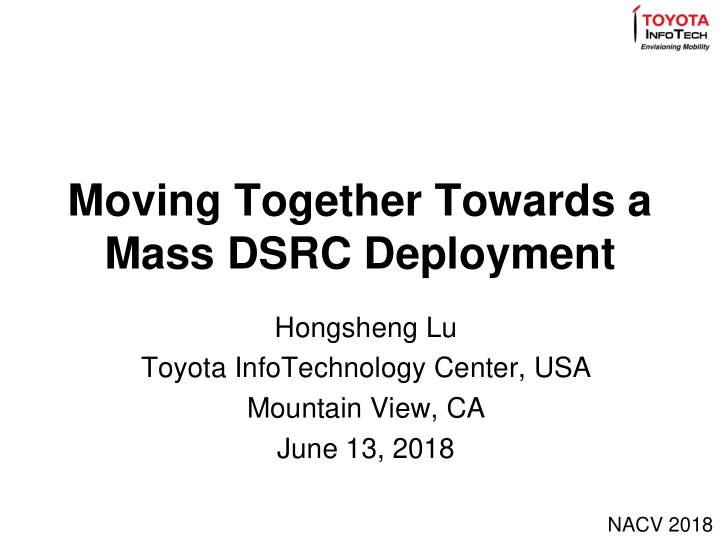



Moving Together Towards a Mass DSRC Deployment Hongsheng Lu Toyota InfoTechnology Center, USA Mountain View, CA June 13, 2018 NACV 2018
Outline • What is DSRC? • What can it do? • Deployment Status • Challenges & Opportunities • Toyota’s vision on DSRC 1
Dedicated Short Range Communication DSRC, a proven, stable and mature technology, helps transform the transportation system 2
Example V2V Applications • Different manufacturers • Communicating on the same channel • Exchanging standard Basic Safety Messages • Enables multiple V2V safety applications Emergency Electronic Brake Lights (EEBL) Radar/Camera unlikely Item to address these two Time Forward Collision Warning (FCW) scenarios 3D Position Position Accuracy Speed Heading Steering Wheel Angle Acceleration Brake Status Left Turn Assist (LTA) Vehicle Size Intersection Movement Assist (IMA) Event Flags Path History Path Prediction Other optional fields Blind Spot / Lane Change Warning (BSW / LCW) RV-1 RV-2 HV 3 Do Not Pass Warning (DNPW)
Example V2I Applications Source: 2013 Team Fair of TEAM STL 4
Channel Usage Plan US DSRC Spectrum Seven 10-MHz Channels 5.925 GHz 5.850 GHz Reserved CH 174 CH 176 CH 180 CH 182 CH 172 CH 184 CH 178 5MHz Safety & Safety & Safety & Safety & Service Service Control Service Service Service Service (safety only) (safety only) Interleaved V2V and V2I limits interference Every channel used for safety apps BSM = Basic Safety Message VRU = Vulnerable Road User PSM = Personal Safety Message WSA = WAVE Service Advertisement C-ACC = Cooperative Adaptive Cruise Control *SAE J2945/0 SCMS: Security Confidential Management System 5
DSRC Deployment • Toyota and Lexus – Japan: started 2015, more than100,000 cars equipped – US: starting 2021, across most of its lineup by mid-2020s • GM – US: started March 2017 with Cadillac CTS – Recently announced: High volume Cadillac models by 2023 • VW announced deployment in EU starting 2019 – Entire VW group (VW, Audi, …) – EU Car2Car Communications Consortium, representing 16 automakers, sets broad deployment target for 2019 • Government-industry collaboration propels numerous deployment projects – CV Pilot Deployments, Smart City, Pool Fund Study, SPaT Challenge etc. 6
Challenges and Opportunities Building 1000 + lives Momentum for mass deployment saved annually Preserving Spectrum Mitigated traffic accidents Budget for infrastructure Business Higher traffic model throughput Less Security Credential air pollution Management System Opportunities Challenges 7
Our Commitment to DSRC Most of the lineups will be equipped by mid-2020s Increased road safety and efficiency Accelerates adoption of V2X capability Encourage all automakers to adopt 5.9GHz DSRC 8
Toyota’s Experience in Japan 9
Right Turn Collision Caution (in Japan) Equivalent to left turn assist in US Driver’s view inside the vehicle Animation for illustration purpose only, Actual design may differ 10
From Alerts to Automation • V2X provides warnings to drivers, and in the future will be used for higher levels of automation 11
More automated driving systems… GPS provides a coarse Computers read measure of the vehicle’s Lasers sense 360 degrees data and regulate position around the vehicle for vehicle behavior objects and localization Wheel-hub sensor that detects Cameras help read traffic revolutions to help light signals and aid in measure the scene understanding vehicle’s motion Orientation sensors Radars measure the speed and measures the car’s range to vehicles across and attitude and balance ahead 12 A version of test vehicle
Cooperative Automation for Greater Benefits Automated Vehicle What the vehicle can SEE Cooperative Automated Vehicle What the vehicle can HEAR e.g, BSMs, sensor data 13
Our Approach to DSRC Deployment (1) • Consensus: rely on specifications and protocols standardized with industry consensus IEEE 802.11 WG IEEE 1609 WG SAE DSRC TC Data dictionary; Message transmission requirements Security; Networking Service; Multi- channel operation lower layer (PHY and MAC) standards 14
Our Approach to DSRC Deployment (1) We emphasize privacy and security No personal identifiable information sent Authentication protects data integrity, validates transmission authority Encryption keeps data secret Security Confidential Management System 15
Our Approach to DSRC Deployment (2) • Support – Preservation of 5.9GHz ITS spectrum – Voluntary deployment now – Eventual mandate of V2V technology 16
Our Approach to DSRC Deployment (3) • Collaboration: – Toyota Motor North America is a member of OmniAir – Helps insure interoperability between OBU and infrastructure, and among OBUs – Embracing work with different stakeholders 17
Our Approach to DSRC Deployment (3) • Encourage: – Automakers to introduce DSRC to their vehicles – Road operators to install DSRC infrastructures – Car/fleet owners to install after market devices to existing vehicles 18
Moving Forward “We believe that greater DSRC adoption by all automakers will not only help drivers get to their destinations more safely and efficiently, but also help lay the foundation for future connected and automated driving systems” - James Lentz, Chief Executive Officer Toyota Motor North America 19
Q&A Contact for more information: hlu@us.toyota-itc.com 20
Recommend
More recommend